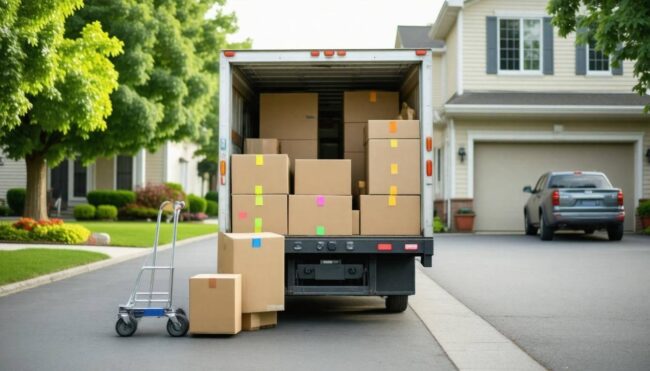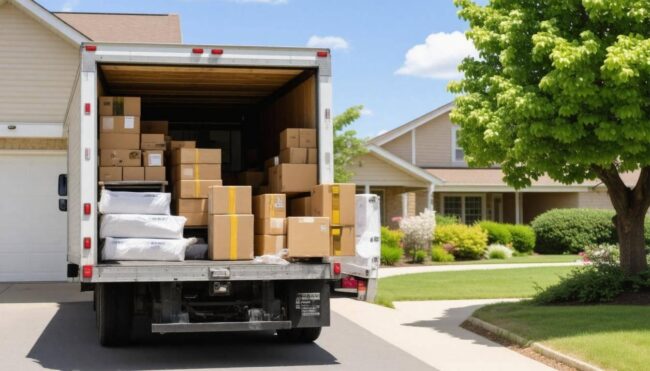When it comes to moving long distances, the process can often feel overwhelming. You’re not just packing up boxes; you’re uprooting your life and taking it somewhere new. This transition can bring anxiety about how to transport cherished belongings safely and efficiently. However, with the right long-distance movers, your experience can turn from hectic to hassle-free. Choosing skilled professionals who understand your needs can make all the difference in ensuring that everything runs smoothly. In this article, we’ll explore essential tips for finding reliable movers, packing effectively, and settling into your new home with ease. Let’s dive in!
A great experience with long-distance movers typically includes timely and efficient service, careful handling of your belongings, clear communication throughout the process, and reasonable pricing without hidden fees. Ensuring you choose a reputable moving company known for reliability and customer satisfaction can significantly enhance your moving experience.

Finding the Right Long Distance Movers
Choosing the proper moving company can feel like navigating a maze, but with a methodical approach, it becomes far less daunting. Start by leveraging online reviews and recommendations. In today’s digital era, insights from real customers are a treasure trove of information about service reliability. Websites like Yelp, Google Reviews, and the Better Business Bureau provide detailed accounts of customer experiences with various moving companies. A staggering 68% of people read these reviews before making any commitments, which emphasizes their crucial role in shaping your decision-making process.
While online reviews offer an initial glimpse into a company’s performance, it’s vital to take it a step further and verify their legitimacy.
Online Reviews and Ratings
Reading through ratings can significantly impact your choice; they help identify companies that excel in professionalism and customer satisfaction. Seek out movers with consistently high ratings and check for patterns in feedback. Are there repeated remarks about friendly staff? Do multiple individuals mention timely deliveries? These trends can give you confidence in your selection.
“A company’s ratings tell a story – one that is often as important as their advertised services.”
Equipped with this knowledge, the next step is ensuring that your selected companies possess the necessary credentials.
Verifying Licenses and Credentials
Always check whether the moving company holds a valid license from the Federal Motor Carrier Safety Administration (FMCSA). This regulation is essential for interstate movers as it ensures compliance with federal guidelines for safe operations. To confirm this, visit the FMCSA’s website to check the validity of their USDOT number. A licensed mover signifies not only legality but accountability should issues arise during your move.
Don’t just stop at licenses; it’s worth checking if the company has any complaints filed against them or unresolved issues highlighted on consumer reporting sites. Reputable companies will be transparent about past grievances.
Once you’ve grouped together a few potential movers based on reviews and credentials, it’s time to initiate conversations with them directly. Understanding their policies and communication style will play a crucial role in your experience.
Initial Contact and Communication
Clear and transparent communication is not just a necessity—it’s your lifeline during a move. When you first reach out to potential moving companies, the goal should be to foster open dialogue that establishes trust. You want to feel confident that the people handling your most cherished belongings understand your needs and priorities. This means taking the time to gather accurate information and expressing any concerns or requirements that might arise.
But!!!! How much does a cross country move cost?
Gathering Accurate Estimates
Initiating contact often begins with obtaining estimates, but don’t just settle for vague quotes. Reach out to your shortlisted movers, providing them with as much detail about your move as possible, which can empower them to provide you with a more accurate picture of costs. The FMCSA recommends acquiring at least three written in-home estimates to compare scope and cost effectively.
It’s crucial that these estimates include specific details such as:
- The distance of your move, which greatly influences transportation costs.
- The estimated weight of your belongings, since many carriers price their services based on weight.
- Any additional services, like packing and unpacking, which can also affect the final price.
By obtaining comprehensive estimates that contain these specifications, you’re laying the groundwork for a smoother moving experience.
Questions to Ask
Don’t shy away from asking questions during this initial contact phase; it reflects your interest and diligence. Inquire about the company’s experience specifically with long-distance moves, as this can reveal useful insights into how they operate under more complex circumstances.
Furthermore, don’t forget to ask about insurance options, which will protect you in case of unforeseen events. You should also clarify whether they subcontract work to other movers or handle all logistics themselves. Subcontracting can sometimes lead to confusion and miscommunication if not managed properly.
Asking these targeted questions helps mitigate potential problems and ensures you won’t encounter hidden fees or unmet expectations during the actual move. By understanding answers comprehensively, you’ll make a well-informed decision that contributes significantly towards ensuring your satisfaction with the moving service.
With estimates gathered and essential questions addressed, it’s time to explore the detailed processes involved in securely preparing your belongings for transport.
Packing and Loading Services

The importance of professional packing services cannot be overstated. When you enlist the help of seasoned movers, they handle your items with care while applying their expertise to maximize packing space. Companies like Allied Van Lines offer tailored packing solutions that cater to your needs, whether you require a full-service option for all your belongings or just fragile-only packing for your cherished glassware. By opting for professionals, you’re ensuring that everything is snugly fitted, securely cushioned, and ready for the journey ahead.
One primary benefit of professional packing is the peace of mind it brings. Experienced packers are familiar with common pitfalls that can lead to damages—such as using inadequate packing materials or neglecting to fill empty spaces in boxes that might shift during transport. As the saying goes: “An ounce of prevention is worth a pound of cure.” Your grandmother’s china set or vintage coffee table takes on new meaning when entrusted to someone who understands how critical it is to protect these items properly.
While some may argue that DIY packing saves money, there’s more to consider than just immediate costs. The risk of damaging valuable possessions during self-packing can quickly outweigh any potential savings.
Labeling and Inventory
Creating an organized system for unpacking begins at the packing stage itself. To facilitate smoother transitions at your new home, it’s crucial to label every box according to its contents and designated room. For example, boxes marked “Kitchen – Dishes” or “Living Room – Books” remove the guesswork from unpacking and allow you to prioritize which boxes to open first upon arrival.
Additionally, making a detailed inventory list before moving day will serve as a safeguard against loss or damage. Whether you choose a spreadsheet, an app on your phone, or simply pen and paper, having a checklist ensures nothing gets overlooked during the hectic moments of loading and unloading.
Once packed and labeled accurately, the focus shifts towards maintaining the utmost safety and security for all your belongings during transportation.
Ensuring Safe Transportation

Transporting your valuables across long distances means taking careful steps to ensure their safety throughout the entire journey. One key consideration is choosing the right truck size. Selecting a truck that comfortably fits your items without leaving excessive empty space can be crucial. A truck that’s too large can lead to shifting during transit, which increases the risk of damage. According to United Van Lines, it’s advisable to conduct a thorough inventory of your items before selecting a truck size. This practice not only helps in choosing appropriately but also makes organizing and loading much smoother.
When you know how much gear you’ll be transporting, you align those needs with available truck sizes, which vary from smaller ones suitable for a one-bedroom apartment to larger models designed for multiple bedrooms. Utilizing a detailed inventory will greatly assist in making this determination while avoiding surprise costs or logistics hiccups later on.
Tracking Your Shipment
Another critical element of safe transportation revolves around tracking your shipment. In today’s digital age, approximately 40% of moving companies offer real-time tracking options via mobile apps or online portals. This feature allows you to have peace of mind by checking the current location of your belongings anytime during transit.
Imagine being able to check on your possessions while they are miles away, watching as they move closer to your new home.
This transparency alleviates anxiety about potential delays or misplacement. Before booking with any company, it might be wise to ask if they provide this service; it could turn out to be a game-changer for you during your move.
Once the truck arrives at your new location, the unloading phase begins. As you prepare for that step, remember that ensuring safety remains paramount throughout the entire process of relocation.
Unloading and Settling In
Efficient unloading helps to reduce stress during the move-in process, allowing you to quickly feel at home instead of wading through a sea of boxes. As soon as you arrive, it’s best to take charge of the situation. Consider not only where each box should go but also how to handle potential issues that may arise. Your first step should always be Inspecting Items Upon Arrival.
Inspecting Items Upon Arrival
As items are unloaded, it’s crucial to check for any damage or missing boxes against your inventory list. This ensures that all your belongings have made the journey intact and can save you from future headaches. Take a moment before you start unpacking; this could mean the difference between a peaceful move-in day and dealing with potential claims down the line.
Quick tip: Take photos of damaged items as evidence for any claims you might need to file later.
After everything has been roughly placed in its designated space, it’s time to focus on Settling In Quickly. Now, this can vary widely based on how hands-on you want to be versus what services were provided by the movers.
Many reputable moving companies offer professional unpacking services, including furniture assembly which can save both time and effort. For instance, companies like North American Van Lines provide these services within premium packages. Enlisting their help means having professionals set up your living spaces effectively, enhancing functionality without added strain on your part. This is particularly advantageous for people who might be exhausted after a long day of travel and lifting.
However, if you’ve chosen a DIY route or if your chosen company doesn’t provide unpacking services, here’s how you can efficiently settle into your new space!
Prioritize areas where you’ll need immediate access—such as bedrooms and kitchens—first. Setting up essential facilities right away offers comfort when all you want is to unwind after a tumultuous day. Try focusing on unpacking larger items before small boxes; it gives an instant sense of accomplishment and transforms the chaos into order remarkably fast.
Tips for Quick Settlement
- Label Boxes Clearly: Ensure you label boxes with their contents and intended rooms beforehand to make unloading easier.
- Establish a Flow: As you’re unpacking, create zones or small sectors for specific categories (kitchen items, bedroom textiles) to streamline the process.
- Work Room by Room: Completing one room before moving on to another keeps the task manageable and creates a defined sense of progress.
One unique aspect often overlooked is how allowing family members or friends to assist can ease the burden of settling in. Delegate smaller tasks—they often jump-start energy and motivation throughout the house while turning the chore into a shared experience.
Whether utilizing professional unpacking services or handling it yourself, maintaining organization is crucial for creating your cozy home swiftly. As we look deeper into the support structures available during your move, examining the nuances of customer assistance might reveal vital details for your journey ahead.
Evaluating Customer Support
When planning a long-distance move, it’s invaluable to prioritize customer support from your chosen moving company. You want to ensure that if anything goes wrong during this significant transition, you have someone in your corner ready to help. A good customer support team acts like an anchor in the stormy seas of relocating, making a difference in how smoothly everything unfolds.
Responsiveness and Availability
Responsive customer support can significantly alleviate concerns about the logistics involved in a move. According to statistics derived from Consumer Reports, companies that offer round-the-clock assistance tend to perform better than those with restricted hours. Imagine you’re faced with an unexpected delay on moving day or have urgent questions about the handling of your possessions. That’s where accessible customer service comes into play, providing reassurance and solutions when they’re most needed.
Having immediate access to support during emergencies can save considerable stress and ultimately lead to smoother resolutions.
Handling Complaints and Resolutions
Another crucial aspect of customer support is how effectively a company addresses complaints and resolves issues. It’s worth examining the procedures they have in place for managing challenges that may arise during your move. For instance, a reputable moving company will not only have a structured method for addressing complaints but will also keep open lines of communication throughout the process. This refers directly back to their responsiveness; quick replies can alleviate frustrations before they escalate.
As you assess potential movers, check online reviews across platforms like Yelp and Google Reviews to gain insight into how previous customers’ concerns were handled. However, keep in mind that no company is perfect; occasional mishaps can happen even with the best intentions. The key is whether the company takes accountability and strives to make things right for their clients. A business willing to learn from its shortcomings demonstrates its commitment to improving services and ensuring customer satisfaction.
By considering these factors related to support, you equip yourself with valuable insights that can significantly enhance your journey through this transition, shedding light on how essential effective communication is in making the process as seamless as possible. Now let’s explore further into the nuances surrounding this experience.
Reflecting on the Overall Experience
Post-move reflection not only helps you understand what worked and what didn’t but can significantly improve your future moving experiences. The journey of relocating is both physical and emotional; taking stock allows you to identify areas for improvement and recognize what aspects contributed most positively to your experience.
For instance, consider how timely the movers were in their arrival and delivery. Did they arrive when expected? Timeliness often sets the tone for the move and contributes to overall satisfaction.
Another crucial element to assess is the condition of your items upon arrival at your new home. When items are well-handled during transit, it reflects positively on the moving company’s professionalism. If you notice damages or missing items, this may warrant further discussion with the company to resolve those issues promptly.
Being aware of these factors enables you to provide accurate feedback later on.
Evaluating the accuracy of initial estimates versus actual costs can also help inform whether or not the service was worth the investment. Where did discrepancies arise? Did the final bill meet your expectations or did unexpected fees occur?
Beyond numerical reflection, consider the quality of customer support during your move. Were representatives responsive? Did they answer all your questions thoroughly? Customer support is vital as it provides reassurance during a potentially stressful time. Clear communication ultimately enhances your overall experience.
One practical suggestion is to share your experience online afterward. Many prospective customers depend on testimonials when selecting a moving company. By sharing your account—whether positive or negative—you help yourself process your own experience and assist others in making informed choices.
Reflecting on these aspects can empower you as a consumer and provide valuable insights into what makes a moving experience truly great or less than satisfactory. Engaging in this reflection serves not only yourself but also contributes to a community navigating the complexities of long-distance relocation.
In essence, thoughtful evaluation enables better decisions for future moves while helping others find their reliable partners in relocation. Your insights can shape a positive moving narrative for many who follow in your footsteps.
